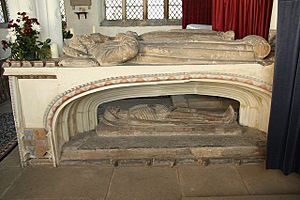St Giles' Church, Holme facts for kids
Quick facts for kids St Giles' Church, Holme |
|
|---|---|

St Giles' Church, Holme
|
|
| 53°7′23.90″N 0°48′5.43″W / 53.1233056°N 0.8015083°W | |
| Location | Holme, Nottinghamshire |
| Country | England |
| Denomination | Church of England |
| History | |
| Dedication | St Giles |
| Architecture | |
| Heritage designation | Grade I listed |
| Administration | |
| Parish | Langford |
| Deanery | Newark and Southwell |
| Archdeaconry | Newark |
| Diocese | Diocese of Southwell and Nottingham |
St Giles' Church in Holme, Nottinghamshire, is a very old and important church. It is a Grade I listed building, which means it is considered to be of exceptional historical interest. This church is part of the Church of England.
History of St Giles' Church
This church was first built in the 12th century, which is over 800 years ago! Most of what you see today was rebuilt in the early 15th century. A man named John Barton led this big rebuilding project.
St Giles' Church is one of several churches in a group of local parishes. These include:
- St Bartholomew's Church, Langford
- St Cecilia's Church, Girton
- All Saints' Church, Harby
- St George the Martyr's Church, North & South Clifton
- All Saints' Church, Collingham
- St John the Baptist's Church, Collingham
- St Helena's Church, South Scarle
- Holy Trinity Church, Besthorpe
- St Helen's Church, Thorney
- All Saints' Church, Winthorpe
The Unique Cadaver Tomb
One of the most interesting features of St Giles' Church is the unique tomb of its founder, John Barton. This type of tomb is called a "cadaver tomb." It shows a realistic sculpture of a decaying body.
John Barton was a very successful wool merchant who lived a long time ago. He passed away in 1491. He made a lot of money from sheep. He even had a saying in his home that showed how important sheep were to his wealth: "I thank God and ever shall, It is the shepe that hath payed for all."
John Barton had his tomb built while he was still alive. The decaying figure on the tomb is a memento mori. This Latin phrase means "remember you must die." It was a common reminder in those times that life is temporary.
At the feet of the figure on the tomb, you can see John Barton's "rebus." A rebus is like a picture puzzle that represents a name. His rebus is a barrel, called a "tun," with a bar across it. This clever design represents his last name, "Barton."
See also
- Grade I listed buildings in Nottinghamshire
- Listed buildings in Holme, Nottinghamshire


